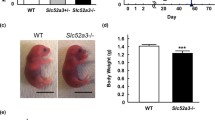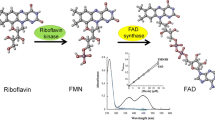Abstract
Deficiency or defective transport of riboflavin (RF) is known to cause neurological disorders, cataract, cardiovascular anomalies, and various cancers by altering the biochemical pathways. Mechanisms and regulation of RF uptake process is well characterized in the cells of intestine, liver, kidney, and brain origin, while very little is known in the heart. Hence, we aimed to understand the expression and regulation of RF transporters (rRFVT-1 and rRFVT-2) in cardiomyocytes during RF deficiency and also investigated the role of RF in ischemic cardiomyopathy and mitochondrial dysfunction in vivo. Riboflavin uptake assay revealed that RF transport in H9C2 is (1) significantly higher at pH 7.5, (2) independent of Na+ and (3) saturable with a Km of 3.746 µM. For in vivo studies, male Wistar rats (110–130 g) were provided riboflavin deficient food containing 0.3 ± 0.05 mg/kg riboflavin for 7 weeks, which resulted in over expression of both RFVTs in mRNA and protein level. RF deprivation resulted in the accumulation of cardiac biomarkers, histopathological abnormalities, and reduced mitochondrial membrane potential which evidenced the key role of RF in the development of cardiovascular pathogenesis. Besides, adaptive regulation of RF transporters upon RF deficiency signifies that RFVTs can be considered as an effective delivery system for drugs against cardiac diseases.





Similar content being viewed by others
References
Barquera B, Zhou W, Morgan JE, Gennis RB (2002) Riboflavin is a component of the Na+-pumping NADH-quinone oxidoreductase from Vibrio cholera. Proc Natl Acad Sci USA 99(16):10322–10324
Lienhart W-D, Gudipati V, Macheroux P (2013) The human flavoproteome. Arch Biochem Biophys 535(2):150–162
Cooperman JM, Lopez R (1984) Riboflavin. In: Machlin LJ (ed) Handbook of vitamins: nutritional, biochemical and clinical aspects. Dekker, New York, pp 299–327
Cumming RG, Mitchell P, Smith W (2000) Diet and cataract: the Blue Mountains Eye Study. Ophthalmology 107(3):450–456
Yonezawa A, Masuda S, Katsura T, Inui K (2008) Identification and functional characterization of a novel human and rat riboflavin transporter, RFT1. Am J Physiol Cell Physiol 295:632–641
Yao Y, Yonezawa A, Yoshimatsu H, Masuda S, Katsura T (2010) Identification and comparative functional characterization of a new human riboflavin transporter hRFT3 expressed in the brain. J Nutr 140(7):1220–1226
Subramanian VS, Subramanya SB, Rapp L, Marchant JS, Ma TY, Said HM (2011) Differential expression of human riboflavin transporters-1, -2, and -3 in polarized epithelia: a key role for hRFT-2 in intestinal riboflavin uptake. Biochim Biophys Acta Biomembr 1808(12):3016–3021
Yoshimatsu H, Yonezawa A, Yao Y, Sugano K, Nakagawa S, Omura T, Matsubara K (2014) Functional involvement of RFVT3/SLC52A3 in intestinal riboflavin absorption. Am J Physiol Gastrointest Liver Physiol 306(2):102–110
Yamamoto S, Inoue K, Ohta KY, Fukatsu R, Maeda JY, Yoshida Y, Yuasa H (2009) Identification and functional characterization of rat riboflavin transporter 2. J Biochem 145(4):437–443
Fujimura M, Yamamoto S, Murata T, Yasujima T, Inoue K, Ohta KY, Yuasa H (2010) Functional characteristics of the human ortholog of riboflavin transporter 2 and riboflavin-responsive expression of its rat ortholog in the small intestine indicate its involvement in riboflavin absorption. J Nutr 140(10):1722–1727
Ericsson TA, Takeuchi Y, Templin C, Quinn G, Farhadian SF, Wood JC, Oldmixon BA, Suling KM, Ishii JK, Kitagawa Y, Miyazawa T, Salomon DR, Weiss RA, Patience C (2003) Identification of receptors for pig endogenous retrovirus. Proc Natl Acad Sci USA 100:6759–6764
Yao Y, Yonezawa A, Yoshimatsu H, Omura T, Masuda S, Matsubara K (2013) Involvement of riboflavin transporter RFVT2/Slc52a2 in hepatic homeostasis of riboflavin in mice. Eur J Pharmacol 714:281–287
Yoshimatsu H, Yonezawa A, Yamanishi K, Yao Y, Sugano K, Nakagawa S, Imai S, Omura T, Nakagawa T, Yano I, Masuda S, Inui K, Matsubara K (2016) Disruption of Slc52a3 gene causes neonatal lethality with riboflavin deficiency in mice. Sci Rep 6:27557
Bosch AM, Abeling NGGM, Ijlst L, Knoester H, Van Der Pol WL, Stroomer AEM, Wanders RJ, Visser G, Wijburg FA, Duran M, Waterham HR (2011) Brown-Vialetto-Van Laere and Fazio Londe syndrome is associated with a riboflavin transporter defect mimicking mild MADD: a new inborn error of metabolism with potential treatment. J Inherit Metab Dis 34:159–164
Griebel V, Krigeloh-Mann I, Ruitenbeek W, Trijbels JMF, Paulus W (1990) A mitochondrial myopathy in an infant with lactic acidosis. Dev Med Child Neurol 32:528–531
Green P, Wiseman M, Crow YJ et al (2010) Brown-Vialetto-Van Laere Syndrome, a ponto-bulbar palsy with deafness, is caused by mutations in C20orf54. Am J Hum Genet 86(3):485–489
Johnson JO, Gibbs JR, Van Maldergem L, Houlden H, Singleton AB (2010) Exome sequencing in Brown-Vialetto-van Laere syndrome. Am J Hum Genet 87(4):567–569
Johnson JO, Gibbs JR, Megarbane A et al (2012) Exome sequencing reveals riboflavin transporter mutations as a cause of motor neuron disease. Brain 135(9):2875–2882
Haack TB, Makowski C, Yao Y et al (2012) Impaired riboflavin transport due to missense mutations in SLC52A2 causes Brown-Vialetto-Van Laere syndrome. J Inherit Metab Dis 35(6):943–948
Duan W, Ladenheim B, Cutler RG, Kruman II, Cadet JL, Mattson MP (2002) Dietary folate deficiency and elevated homocysteine levels endanger dopaminergic neurons in models of Parkinson’s disease. J Neurochem 80(1):101–110
Kruman II, Culmsee C, Chan SL, Kruman Y, Guo Z, Penix L, Mattson MP (2000) Homocysteine elicits a DNA damage response in neurons that promotes apoptosis and hypersensitivity to excitotoxicity. J Neurosci 20(18):6920–6926
Clare R, Daly L, Robinson K, Naughten E, Cahalane S, Fowler B, Graham I (1991) Homocysteinemia: an independent risk factor for vascular disease. NEJM 324(17):1149–1155
Stampfer MJ, Malinow MR, Willett W, Newcomer LM, Upson B, Ullmann D, Tishler PV, Hennekens CH (1992) A prospective study of plasma homocysteine and risk of myocardial infarction in US physicians. JAMA 268:877–881
Boushey CJ, Beresford SA, Omenn GS, Motulsky AG (1995) A quantitative assessment of plasma homocysteine as a risk factor for vascular disease. Probable benefits of increasing folic acid intakes. JAMA 274:1049–1057
Wang CY, Chen ZW, Zhang T, Liu J, Chen SH, Liu SY, Han LY, Hui ZH, Chen YM (2014) Elevated plasma homocysteine level is associated with ischemic stroke in Chinese hypertensive patients. Eur J Intern Med 25(6):538–544
Reid RA, Moyle J, Mitchell P (1992) Synthesis of adenosine triphosphate by a proton motive force in rat liver mitochondria. Nature 212:257–258
Ratter F, Gassner C, Shatrov V, Lehmann V (1999) Modulation of tumor necrosis factor-alpha-mediated cytotoxicity by changes of the cellular methylation state: mechanism and in vivo relevance. Int Immunol 11(4):519–527
Lassus P, Opitz-Araya X, Lazebnik Y (2002) Requirement for caspase-2 in stress-induced apoptosis before mitochondrial permeabilization. Science 297:1352–1354
Zivkovic V, Jakovljevic V, Djordjevic D, Vuletic M, Barudzic N, Djuric D (2012) The effects of homocysteine-related compounds on cardiac contractility, coronary flow, and oxidative stress markers in isolated rat heart. Mol Cell Biochem 370:59–67
Chan J, Deng L, Mikael LG et al (2010) Low dietary choline and low dietary riboflavin during pregnancy influence reproductive outcomes and heart development in mice. Am J Clin Nutr 91(4):1035–1043
Wang J, Yuan X, Sun B, Cao Y (2011) Inhibition of lipid peroxidation by enzymatic hydrolysates from wheat bran. Food Technol Biotechnol 49(4):481–488
Schaus R, Kirk JE, Lauresn TJS (1955) The riboflavin content of human aortic tissue. J Gerontol 10:170–177
Ashokkumar B, Mohammed ZM, Vaziri ND, Said HM (2007) Effect of folate oversupplementation on folate uptake by human intestinal and renal epithelial cells. Am J Clin Nutr 86(1):159–167
Rohrbach S, Yan X, Weinberg EO, Hasan F, Bartunek J, Marchionni MA, Lorell BH (1999) Neuregulin in cardiac hypertrophy in rats with aortic stenosis. Differential expression of erbB2 and erbB4 receptors. Circulation 100(4):407–412
Ashokkumar B, Vaziri ND, Said HM (2006) Thiamin uptake by the human-derived renal epithelial (HEK-293) cells: cellular and molecular mechanisms. Am J Physiol Renal Physiol 291(4):796–805
Bates CJ, Fuller NJ (1986) The effect of riboflavin deficiency on metheylenetetrahydrofolate reductase (NADPH) and folate metabolism in the rat. Br J Nutr 55:455–464
Kumar CK, Yanagawa N, Ortiz A, Said HM (1998) Mechanism and regulation of riboflavin uptake by human renal proximal tubule epithelial cell line HK-2. Am J Physiol 274:F104–F110
Huang S, Swaan PW (2001) Riboflavin uptake in human trophoblast-derived BeWo cell monolayers: cellular translocation and regulatory mechanisms. J Pharmacol Exp Ther 298(1):264–271
Said HM, Wang S, Ma TY (2005) Mechanism of riboflavin uptake by cultured human retinal pigment epithelial ARPE-19 cells: possible regulation by an intracellular Ca2+-calmodulin-mediated pathway. J Physiol 566:369–377
Lakshmi R, Lakshmi V, Bamji MS (1990) Mechanism of impaired skin collagen maturity in riboflavin or pyridoxine deficiency. J Biosci 15(4):289–295
Adams JE, Abendschein DR, Jaffe AS (1993) Biochemical markers of myocardial injury. Is MB creatine kinase the choice for the 1990s? Circulation 88(2):750–763
Sipkens JA, Krijnen PAJ, Meischl C et al (2007) Homocysteine affects cardiomyocyte viability: concentration-dependent effects on reversible flip-flop, apoptosis and necrosis. Apoptosis 12(8):1407–1418
Forneris F, Battaglioli E, Mattevi A, Binda C (2009) New roles of flavoproteins in molecular cell biology: histone demethylase LSD1 and chromatin. FEBS J 276:4304–4312
Gomez J, Sanchez-Roman I, Gomez A, Sanchez C, Suarez H, Lopez-Torres M, Barja G (2011) Methionine and homocysteine modulate the rate of ROS generation of isolated mitochondria in vitro. J Bioenerg Biomembr 43(4):377–386
Lu Y, Low PS (2002) Folate-mediated delivery of macromolecular anticancer therapeutic agents. Adv Drug Deliv Rev 54:675–693
Russell-Jones GJ, Westwood SW, Habberfield AD (1995) Vitamin B12 mediated oral delivery systems for granulocyte-colony stimulating factor and erythropoietin. Bioconjug Chem 6:459–465
Acknowledgements
BA acknowledges DBT-RGYI, INDIA for the financial support [No. BT/PR15134/GBD/27/330/2011] and ICMR, India for the International Biomedical Scientists Fellowship (No. INDO/FRC/452/(Y83)/2016-17-IHD). TU thank DST-PURSE, MKU for the fellowship. Authors gratefully acknowledge DST-PURSE Program (India), Madurai Kamaraj University for the infrastructure and facilities.
Author information
Authors and Affiliations
Corresponding author
Ethics declarations
Conflict of interest
Authors have no conflict to declare in this research.
Electronic supplementary material
Below is the link to the electronic supplementary material.

11010_2017_3163_MOESM1_ESM.jpg
Supplementary Figure S1: Qualitative assay to detect the presence of Cardiac Troponin-I. Control (A) and RF deficient (B) rat using Troponin-I test strip. The presence of band in the test region of RF deficient sample indicates that the concentration of Troponin-I is greater than 1.5 ng/mL. Supplementary material 1 (JPEG 100 kb)
Rights and permissions
About this article
Cite this article
Udhayabanu, T., Karthi, S., Mahesh, A. et al. Adaptive regulation of riboflavin transport in heart: effect of dietary riboflavin deficiency in cardiovascular pathogenesis. Mol Cell Biochem 440, 147–156 (2018). https://doi.org/10.1007/s11010-017-3163-1
Received:
Accepted:
Published:
Issue Date:
DOI: https://doi.org/10.1007/s11010-017-3163-1




